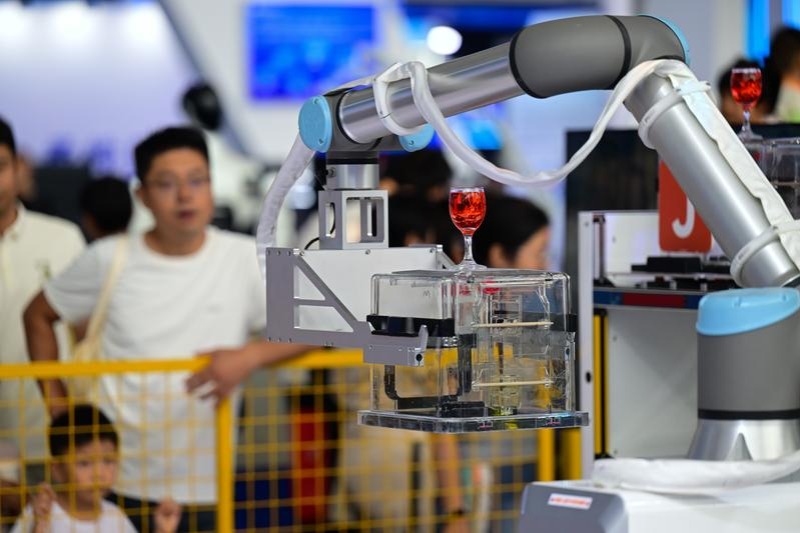Innovation nation

The second-largest economy is working to be second to none for new technologies and businesses, reports William Hennelly in New York.
Whether it's a mix of national pride, the sheer numbers of its population and an unrelenting work ethic, innovation in China is barreling forward, and the world is taking notice.
In the past decade, Chinese innovation and companies have emerged in diverse fields such as artificial intelligence, biotechnology, drones, e-commerce, electronic vehicles, life sciences, mobile telecommunications, high-speed rail, robotics, supercomputing and virtual reality.
Now China is taking steps to protect its own intellectual property, whereas in the past, other nations looked to protect their IP from China.
"If you were to call me a bunch of years ago" and ask about innovation, "I would say not enough money, not enough qualified people, very outdated infrastructure," said Denis Simon, PhD, the executive vice-chancellor at Duke Kunshan University in Jiangsu province.
"If you asked me the question today, I would tell you (China has) more than enough money, more than enough qualified people, and a very good and increasingly getting better infrastructure."
Simon said "the whole landscape of the innovation system has changed dramatically as a result of over the last 10 years of investment that the Chinese government has put in."
"Money doesn't buy innovation," he said. "What buys innovation is opening up the system in order to allow entrepreneurial-oriented scientists to explore their creative pathways and be unencumbered in what they do in terms of discovery and then eventually commercialization."
Simon said that now and particularly over the last two or three years China has demonstrated "some amazing changes in the attitudes about giving scientists and engineers much more leeway and much more room to explore their opportunities in the research system".
"By removing some of the shackles, by making money more available, by making it easier to get grants, etc., the state is changing its posture. So rather than primarily (having) a top-down driven innovation system, China now increasingly is showing signs that the bottom-up part of the innovation system is yielding results."
Simon said that "more and more American scientists see opportunities of collaboration and also commercialization in China as being an attraction to give them the push to work with a Chinese partner on projects".
He said one professor at his school, Dr David Brady, is one of the world's leaders in optics technology.
"That is the camera of the 21st century," Simon said. "He is developing the lens technology that will now replace or at least be a major advancement over the existing technologies that now dominate cameras and security cameras.
"David went out to China because the United States is no longer a player in the camera industry. And China is now the emerging star in cameras."
Spreading the word
In a recent survey by accounting firm KPMG, China was second only to the United States in being the country most likely to produce disruptive technologies that have global impact.
For the first time in its 31-year history, on March 11, SouthBy Southwest (SXSW) presented Chinese tech innovation at its interactive session in Austin, Texas.
GeekPark, a technology community featuring Chinese companies, selected a handful of exhibitors to "evangelize" the quality, innovation and ingenuity of China's products, concepts and technologies.
The panelists of GeekPark's "China Gathering" discussed the nation's march into a new age of innovation.
"We are thrilled to bring these exhibitors to a global audience at the world's premier celebration of interactive technology," Peng (Jack) Zhang, founder and CEO of GeekPark, said at SXSW.
In a Q&A with China Daily, Zhang said, "In many tech fields, China is not the most advanced. But Chinese innovators are indeed good at figuring out the most available and the most feasible applications. That's why you may see more and more tech-driven products in China, even earlier adopted than the US, not only to use a particular tech, but also to create value for both business and people's good.
"The mobile internet's fast development in China gives birth to a new generation of entrepreneurs, who are equipped with new mindsets and vision, who believe in the power of techs, and who master new ways of thinking and doing business," Zhang said.
"They have better educational backgrounds. And they (are) a generation to go beyond copycats. You may find they do not only care about how successful the business itself is, but also how to achieve success and what deeper impact they will bring about via the success.
"Secondly, the high penetration of mobile devices in China enables the society to become more open-minded. People become more inclined to adopt new things. It makes many things possible," Zhang said.
He listed as examples "the prevalence of sharing bikes, the popularization of WeChat Pay and Alipay, the penetration of on-demand economy (food delivery, housekeeping, etc.), the industrialization of live streaming, etc.".
Xiaojie Huang, CEO of Baofeng Mojing, which produces mobile virtual reality technology, said he "can see innovative technology, products, models continue to emerge. Innovation has been deeply rooted in people's mindset."
"On the one hand, it is the evolving of R&D, education level, professionalism and user base, which are the soil and foundation of tech innovation. On the other hand, more importantly, innovation culture becomes an inclusive atmosphere. Innovators' mindset and users' acceptance are decisive factors in the rapid growth of Chinese innovation.
"The most trending are VR, AI, big data, and cloud computing. In recent years, the government has vigorously promoted innovation and entrepreneurship and led the organization of industry forums and meetings, (which has) greatly encouraged the entrepreneurs' confidence."
Innovation is set to be the major driver of the Chinese economy, leading its move into new faster-growing and more dynamic sectors, according to a Government Work Report.
Premier Li Keqiang stressed research and development in the report to the National People's Congress on March 5.
"We will do more to implement the strategy of innovation-driven development, upgrade the structure of the real economy and improve its performance and competitiveness," he said.
Li said investment in R&D was crucial for China to implement its Made in China 2025 initiative aimed at making the country internationally competitive in key industries such as advanced IT, robotics and machine tools, railway technology, aerospace and maritime equipment and high-tech shipping.
Li said that new, small, private sector businesses hold the key to innovation. Over the past year, the number of new businesses registered in China increased 24.5 percent, with 15,000 new businesses being created on average each day.
President Xi Jinping said initiatives such as the Shanghai Free Trade Zone will play a leading role in boosting China's innovation efforts.
The zone, which has 40,000 registered businesses in sectors such as e-commerce and medical services, opened in 2013.
"China's opening door will not close again," Xi said.
Robin Li, chairman and CEO of Baidu, told the Chinese People's Political Consultative Conference (CPPCC) on March 3 of the importance of artificial intelligence and called for policies for its development.
"Like the profound impact of the Industrial Revolution, today we've reached a tipping point where AI gets to bring sweeping changes to our lives, with so many achievable applications to be rolled out," he said.
China now has 156 national high-tech industrial zones, with operating revenue of $4 trillion (27.9 trillion yuan) in 2016.
Those zones accounted for 11.7 percent of China's GDP in 2016 and 18 percent of China's exports, according to Zhang Zhihong, director of Torch High Technology Industry Development Center, Ministry of Science & Technology.
"The high-tech zones have become a major engine to China's economic growth," Zhang said.
"Nearly 4,300 spaces provided services for more than 120,000 enterprises in 2016," said Zhang.
Multiple tech centers

Many disparate areas in China are emerging as technology hubs, such as Shanghai, Shenzhen, Chengdu, Guangdong province, Hong Kong and Tianjin.
"The success of the Silicon Valley ecosystem has yielded a real innovation entrepreneurship throughout the world, and China has taken advantage of it, leveraging the massive consumer base in China," said Tim Zanni, KPMG's global and US technology leader.
"Silicon Valley has a developed mentor community, but the mentor community is extremely poor in China," he said. "The big banks in China haven't yet put their arms around startups to help them, and there hasn't been any big brother or big sister to help startups. This is one big thing we are missing from Silicon Valley," Zarrella added.
"It is just part of the evolution. If you have smart young people, great universities and sufficient government support and equity capital coming in, there will be a successful company, and the company will breed more successful companies," Zarrella said.
Chengdu, capital of Sichuan province, is turning from a traditional military-industrial base into an innovation star, due to China's civil-military integration strategy.
Xi urged the military at the 12th National People's Congress in Beijing on March 12 to further boost integration with civilian sectors while highlighting scientific and technological innovation as the key to military upgrades.
He told officers to look for, support and make use of advanced technologies that can help modernize the military and assist the transfer of defense technologies to the business sector. Institutional barriers and special interest groups must be removed to pave the way for civilian-defense integration, he said.
Beijing Venustech Inc, a provider of network security, has opened a branch in Chengdu Science City, a hub of technology, industry and business in the Tianfu New Area.
Ma Huateng, chairman of Tencent and an NPC deputy, said the Guangdong-Hong Kong and Macao area could be a global technology hub.
"Hong Kong will take the lead among these cities in international transportation, as well as accounting and financial, legal and other commercial services. Dongguan (in Guangdong) specializes in manufacturing. And Shenzhen hosts China's high-tech giants, such as Tencent and Huawei as well as drone maker DJI," he said.
Such a new "Silicon Valley" could be girded by the completion next year of the Hong Kong-Zhuhai-Macao Bridge.
The span will link Zhuhai in Guangdong with Hong Kong and Macao and be the world's longest sea-crossing bridge. The area is one of China's most affluent, with a GDP of 2 trillion yuan in 2016.
Shenzhen has become a hotbed of startup tech firms. Some 16 percent of the city's population was engaged in early-stage entrepreneurial activities in 2016.
On March 27, computer maker Lenovo Group Ltd signed a strategic partnership agreement with Tianjin in North China to expand its smart internet business.
"A new era for smart internet has come. In the future, China's economy will be increasingly driven by technology," said He Zhiqiang, president of Lenovo Capital and Incubator Group.
Several subsidiaries and enterprises invested in by Lenovo will cooperate with the Binhai New Area of Tianjin on augmented reality, cloud computing and medical information.
Internet company Baidu set up a national deep learning technology lab in Beijing in March.
"The internet is just an appetizer. The main course will be AI. In the future, machines will develop to a point where they can understand humans and their intentions," said Baidu chairman Li at the China IT Summit in Shenzhen earlier this month.
Baidu has invested in machine-aided study, image recognition, voice recognition and driverless vehicles.
Xiaomi set up an "Explorer's Lab" last year to research artificial intelligence and will release an "exciting AI product" in the coming six months, said Lei Jun, founder and CEO.
Diverse industries
"If we define 2016 as the first year of China's artificial intelligence, this year will be the beginning of applications of artificial intelligence in the country," said Liu Qingfeng, chairman of tech firm iFlytek Co Ltd.
"We will accelerate R&D on and commercialization of new materials, artificial intelligence, integrated circuits, biopharmacy, 5G mobile communications and other technologies and develop industrial clusters in these fields," said the Government Work report in March.
Wang Qing, professor of marketing and innovation at Warwick Business School, said China is catching up with the West after lagging in the 1970s.
"I think China in some areas already is very close to what is cutting edge and, maybe in a couple of areas, they might even be more advanced," she said.
She believes one such area is high-speed rail. China opened its first line in 2007 and now operates 19,000 kilometers of track, more than the rest of the world's high-speed rail networks combined.
"They actually started in high-speed rail by borrowing Japanese technology, but because of a lot of unique problems, they had to do lots of innovations on top because of what they learned," she said.
"Because of the scale of the country's high-speed rail development, they have also accumulated experience that some other countries would not have."
"Innovation is to some extent a numbers game. If you just have one idea per 1,000 people, then a country that has a 1.4 billion population is going to have an advantage over anyone else," said Max von Zedtwitz, managing director of GLORAD, an R&D think tank in Shanghai and San Francisco.
But China is not going it alone on innovation. In fact, it's quite the contrary.
"It has done so not in isolation," said Simon of Duke Kunshan University. "What really is happening is that the Chinese now are seeing themselves benefiting from having a rather expansive set of international science and technology relations. And those relationships are now yielding big results.
"It's very much a globally integrated innovation," he said. "China is benefitting substantially by its engagement with the West and other parts of the world, the mobility of Chinese scientists, the fact that international conferences, major conferences and workshops are held in China.
"Innovation no longer occurs in a kind of Lone Ranger motif. Everyone is now part of some transnational collaborative knowledge network. And increasingly, Chinese scientists are a regular part of those networks," he said.
"And that's what I think is helping to spur Chinese innovation. It's the changes within the system, combined with the increasing integration into the international science and technology system, that now have enabled China to move forward in a much faster, much more concerted way than it has in the past," he said.
Contact the writer at williamhennelly@chinadailyusa.com
Shanghai: A successor to Silicon Valley?
A recent survey by accounting firm KPMG rated Shanghai as the most likely city to rival Silicon Valley in the future.
The survey, titled The Changing Landscape of Disruptive Technologies, polled 832 technology leaders; 43 percent believe the tech innovation center of the world is likely to move from Silicon Valley to another country in the next four years, with China picked as the most likely alternative.
Sixty-five percent of respondents said China could replace the California giant in four years.
Shanghai was picked by 26 percent of respondents as the next Silicon Valley, followed by New York, Tokyo, Beijing and London.
"Shanghai is bound to remain among the world's leading innovation hubs given its growing base of digital media and entertainment companies and a more pleasurable lifestyle and favorable climate that can draw top expertise," said Egidio Zarrella, partner of clients and innovation at KPMG China.
- William Hennelly
| Workers assemble parts for an A320 aircraft at an AVIC Chengdu Aircraft Industrial plant. The company has innovated and integrated its technologies, which were previously developed for national defense purposes. Xinhua |
(China Daily USA 04/14/2017 page20)
Today's Top News
- Japan's PM seen as playing to right wing
- Mainland increases entry points for Taiwan compatriots
- China notifies Japan of import ban on aquatic products
- Envoy: Japan not qualified to bid for UN seat
- Deforestation is climate action's blind spot
- Japan unqualified for UN Security Council: Chinese envoy































